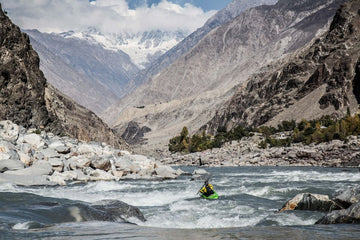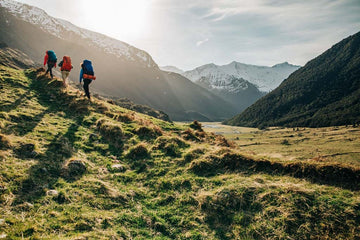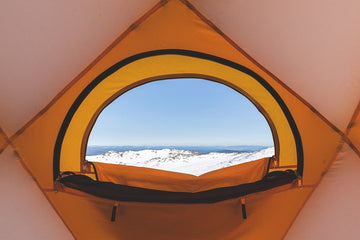Looking for Joe – A kayaking adventure in the heart of Fiordland
by celine sav on Oct 03, 2025

November 2024
Looking for Joe – A kayaking adventure in the heart of Fiordland
Hear from Mike Dawson, a 2024 North Face Adventure Grant recipient, who brought together a team of young kayakers to introduce them to the world of kayak touring in the New Zealand wilderness.

The Joe River's allure is irresistible: it's a well-known but little-explored river. It drains the Olivine Glacial Plateau, hidden deep in Mount Aspiring National Park, in one of New Zealand's most remote regions. The inability to access it by car or plane makes reaching the whitewater gorges a 3- to 4-day human-powered portage across the Barrier Range. For us, this expedition was, above all, an off-the-beaten-track exploration, an adventure to a river a little deeper into the wilderness.

Logistics and planning are essential before embarking on an adventure like this. Even more so with a team with diverse backgrounds. For River and George, this was their first real foray into the great outdoors. As the sun set on March 27, the team was packing and repacking, trying to find the perfect balance between weight and equipment. We had to be completely self-sufficient, with enough food for eight days, kayaking gear, safety equipment, and alpine gear. In total, we would be carrying between 45 and 50 kg on our backs to complete this multi-discipline adventure—and we weren't even sure it would all fit.

The plan was simple: head upstream using the Dart River as a route to the remote area, before crossing it and attempting the Barrier Range ascent, traversing the back of Mount Frobisher, and diving into the Joe River. From there, we would enter the river by crossing three gorges before following the Arawhata River and paddling to the west coast of the South Island. In the early hours of March 28, the team, consisting of River Mutton, Mike Dawson, and George Snook, paddled up the Dart River, loaded for the seven-day expedition. The rising sun on the first day revealed the recent snowfall visible on the alpine ridges, significantly heavier than expected, sowing seeds of doubt in our minds.
Arriving at Chinamans Bluff, just outside Glenorchy, I began to realize the magnitude of the task ahead. My kayak was loaded, and I was struggling to get it launched. Huge peaks were covered in snow. The start was a daunting moment. – Mike Dawson
We traveled 26 km upriver to the base of O'Learys Pass, carrying our boats on our shoulders or pulling them along the riverbed. The highlight of the trip was the trip up the Dart River to Mount Frobisher and O'Learys Pass, our gateway to the Olivine and Joe River. A long climb through the bush to the alpine zone, we were aware that we were moving slower than expected due to the weight and the difficulty of maneuvering the boats through the thick bush. Given the significant amount of snow on the ridge, the best course of action was to scout the route to the pass and assess whether it was possible.


Until now, our knowledge consisted mainly of contour lines and satellite images. The ascent to the Alps was arduous. Fresh snow was accumulating at around 1,100 m, making the climb to the ridge a difficult one. The direct route to O'Learys was impassable in these unstable snow conditions. Looking for an alternative, we found a route leading to the ridgeline at 1,850 m. The gradient was steep, with long sections requiring digging holes through about 50 cm of fresh snow. From the ridge, we could see the Joe River, a day's walk from where we were. Knowing that it was impossible to continue safely in these conditions, the best decision was to turn back, leaving the Joe River for another day.
It was a difficult decision to make. I had been focusing on my river trip since 2019, and turning back was difficult. At the end of the day, the important thing is to be out there, exploring new horizons, but you always have to make sure everyone goes home… the river is here to stay. – Mike Dawson
There's always a silver lining to every change of plan. Within hours, a new plan was in place. We'd been told about an epic whitewater section in the upper Dart, near the confluence with Snowy Creek. We spent the next two days paddling up the Dart, a physically demanding 20 km further upstream. Late in the evening of day four, we arrived at the Dart Hut as darkness fell, our bodies broken from the weight of the load. We were immediately excited about the river. The gradient and flow seemed perfect. The team couldn't wait to get up and get in the water. At sunrise, we dropped into the upper Dart Gorge. With little beta, progress was slow. The river dropped as much as 250 m/km in places—a seriously steep gradient for a kayaker; so we expected some portaging, but what we found was a relentless and unforgiving riverbed. A pile of rocks that was virtually impossible to cross. Our speed had dropped to less than 200 mph in places, requiring constant teamwork, roping up and navigating our boats downstream through boulders the size of houses. As the day wore on, we were exhausted.
“It was the most brutal portage I’ve ever done. Our boats were overloaded, and the river never gave us anything. We had to constantly climb, jump off rocks, and tie up the boats. It was an intense day on the river.” – Mike Dawson
As night approached, with nowhere to sleep and the river still flowing downstream, we began the difficult journey up the gorge, roping up each boat one by one. By 11 p.m., we were out and able to rest for the night. The next day, we returned to the river further downstream and encountered the same characteristics. The flow was good, but siphons and impassable rapids slowed our kayaking progress, forcing us to portage downriver.
Eventually, the gradient eased and we arrived at the Dayleys Flat swing bridge, a spot we had crossed five days earlier. A sense of relief washed over us: even though these weren't the rapids we were looking for, now everything was navigable by boat.


I was thrilled to get to that bridge. The river was relentless and really challenging—and it marked the end. When you enter an area like that, you expect to find gorge magic, waterfalls, or epic rapids, but the Dart offered none of those. It's a bit depressing to portage your boat for six days hoping to find something. But looking around, it's just an extraordinary place, and being in a new, unfamiliar place is incredible—worth it, even if you don't have access to the joys of whitewater. – Mike Dawson

Six days after arriving in the park, we returned to our starting point, unable to make the first descent of the Joe, but thrilled with an epic adventure. This trip was a constant reminder that the wilderness can be unforgiving and that, no matter how intense our desires, we must be patient.


